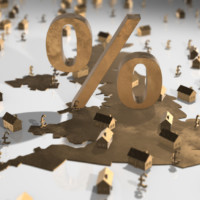
The survey, which was conducted between 2 and 20 March, showed lenders expected a slowdown and tightening in business to happen in the second quarter of the year before pandemic-related restrictions were put into place.
Scores are generated based on lender responses to how much conditions have changed and weighted based on market share.
Positive scores reflect that lenders expect credit to be cheaper or looser and demand, credit availability and defaults to be higher.
The results, the net percentage balance, is the difference between favourable and unfavourable responses on a scale of +100 to -100.
Lending and demand
Lenders expect a huge decline in the demand for credit for both house purchases and remortgage in the second quarter of the year.
This is in contrast to the increased demand that was recorded across all categories in the first quarter, suggesting an improving market after sluggish 2019.
With house purchase demand receiving a positive response score of 28 for the first three months of the year, the sentiment among lenders plummeted by 99 points with expectations for the next three months recorded at –71.
The responses to remortgaging demand saw a 70 point drop compared to what was actually lent in Q1, with expectations in Q2 receiving a score of –32.
The demand for buy-to-let lending is also expected to fall as the response score fell by 75 points to –66.
Falling LTVs
Lenders will also be less willing to lend to borrowers with housing equity less than 10 per cent of the value of their homes over the next three months.
Responses had a net percentage balance of –21, far below the positive score of six recorded for the lending given to such borrowers in Q1.
The survey also found that the availability of secured credit was predicted to fall in the three months to May 2020, particularly for borrowers with loan to value (LTV) ratios of 75 per cent and higher. Responses to this question were given a score of –25, a significant drop from the –4 in actual high LTV lending that was reported in Q1.
Tightening credit, rising defaults
Additionally, it is expected lending will be less profitable as following a decline in interest rate spreads in Q1, respondents forecast this would fall further in the second quarter.
Overall, the net percentage balance of lenders who believe interest rate spreads would decline fell to –37 from the near status quo recorded in Q1.
Lenders predicted credit scoring criteria for loan applications would tighten over the next three months and suggested there would be a drop in the number of loan approvals.
Approvals, were unchanged for the first quarter of the year, but the sentiment among lenders slipped to –26 for the upcoming quarter.
Defaults are also expected to rise in the three months to May, lenders said, despite declines being recorded in the first quarter of the year.
Change in confidence
Tomer Aboody, director of property lender MT Finance, said: “The first quarter was an extremely confident one for the property market, with lenders and borrowers alike looking strong in credit borrowings and lower defaults.
“Fast forward a month or two, and the outlook has dramatically changed due to the economy grinding to a standstill and credit borrowing levels decreasing.”
However, Aboody predicted a “strong” fourth quarter of the year and first quarter of the next due to government stimulus and assistance for businesses.
“The upward movement should start within two or three months of lockdown ending,” he added.
















